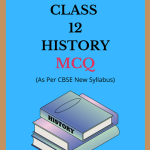NCERT Class 12 History MCQ Chapter 9 Kings and Chronicles The Mughal Courts Solutions to each chapter is provided in the list so that you can easily browse through different chapters NCERT Class 12 History MCQ Chapter 9 Kings and Chronicles The Mughal Courts and select need one. NCERT Class 12 History MCQ Chapter 9 Kings and Chronicles The Mughal Courts Question Answers Download PDF. NCERT History MCQ Class 12 Solutions.
NCERT Class 12 History MCQ Chapter 9 Kings and Chronicles The Mughal Courts
Also, you can read the NCERT book online in these sections Solutions by Expert Teachers as per Central Board of Secondary Education (CBSE) Book guidelines. CBSE Class 12 History MCQ Solutions are part of All Subject Solutions. Here we have given NCERT Class 12 History MCQ Part – I: Themes in Indian History, History MCQ Part – II: Themes in Indian History, History MCQ Part – III: Themes in Indian History. NCERT Class 12 History MCQ Chapter 9 Kings and Chronicles The Mughal Courts Notes, NCERT Class 12 History MCQ Notes for All Chapters, You can practice these here.
Kings and Chronicles The Mughal Courts
Chapter: 9
| THEMES IN INDIAN HISTORY (PART – II) |
| MCQ |
1. Who of the following was the author of Badshah Nama?
(a) Inayat Khan.
(b) Abdul Hamid Lahori.
(c) Gulbadan Begum.
(d) Abul Fazl.
Ans: (b) Abdul Hamid Lahori.
2. Which among the following books was authored by a lady of the Mughal Royal House?
(a) Babar Namah.
(b) Akbar Namah.
(c) Humayun Namah.
(d) Badshah Namah.
Ans: (c) Humayun Namah.
3. Painting reached its highest level of development during the reign of:
(a) Akbar.
(b) Aurangzeb.
(c) Jahangir.
(d) Shah Jahan.
Ans: (c) Jahangir.
4. Who introduced Jharokha Darshan?
(a) Akbar.
(b) Humanyun.
(c) Jahangir.
(d) Shanjhan.
5. Who was the famous painter of Safavid court?
(a) Abdus.
(b) Mir Sayyid.
(c) Abdul Hamid.
(d) Bihzad.
Ans: (d) Bihzad.
6. Who translated Akbarnama in English?
(a) Thomas Roe.
(b) Ralf Fitch.
(c) Henry Beveridge.
(d) Monserrate.
Ans: (c) Henry Beveridge.
7. The correct meaning of Sulah-e-kul is:
(a) Universal happiness.
(b) Adjustment in family.
(c) Peace in family.
(d) Universal peace.
Ans: (d) Universal peace.
8. The two artists, Mir sayyid ali and Abdus Samad were brought from Iran to the Mughal court by Emperor—.
(a) Akbar.
(b) Humanyun.
(c) Jahangir.
(d) None of the above.
Ans: (b) Humanyun.
9. Which styles of sculpture are found in Mughal Art?
(a) Sino-Indian.
(b) Indo-European.
(c) Indo-Persian.
(d) Indo-Greek.
Ans: (c) Indo-Persian.
10. Akbar promulgated Din-i-Ilahi in 1581. It was:
(a) A code of conduct.
(b) An Islamic doctrine.
(c) A Hindu law influenced by Islam.
(d) None of the above.
Ans: (a) A code of conduct.
11. Find out from the following pairs which one is correctly matched:
(a) Akbar Nama: Abdul Hamid Lahori.
(b) Badshah Nama: Zahiruddin Babur.
(c) Humayun Nama: Gulbadan Begum.
(d) Babur Nama: Abul Fazi Allami.
Ans: (c) Humayun Nama: Gulbadan Begum.
12. Consider the following events.
(i) Gulbadan Begum to write the Humayun Nama.
(ii) Abul Fazl works on the Akbar Nama.
(iii) Jahangir wrote his memoir-the Jahangir Nama.
(iv) Lahorn completed the first two daftars of the Badshah Nama.
The correct chronological order of the events:
(a) (iv), (ii), (i), (iii)
(b) (i), (ii), (iii), (iv)
(c) (ii), (iv), (i), (iii)
(d) (2), (iv), (iii), (ii)
Ans: (b) (i), (ii), (iii), (iv)
13. Arrange the following:
(i) The Buland Darwaja.
(ii) Dargah of Shaikh Muinuddin Chisti.
(iii) The Red Fort.
(iv) Capital of Fatehpur Sikri.
Options:
(a) (i), (ii), (iii), (iv)
(b) (iv), (iii), (ii), (i)
(c) (i), (ii), (iv), (iii)
(d) (iv), (ii), (i), (ii)
Ans: (d) (iv), (ii), (i), (ii)
14. Who gave the title Mirza Raja to his two highest-ranking nobles?
(a) Akbar.
(b) Humanyun.
(c) Jahangir.
(d) Aurangzeb.
Ans: (d) Aurangzeb.
15. Mughal chronicles present the empire as comprising many different ethnic and religious communities. These were:
(a) Hindus, Muslims, Jains, Zoroastrians.
(b) Hindus, Muslims, Jains, Buddhist.
(c) Hindus, Muslims, Buddhist, Zoroastrians.
(d) Hindus, Buddhist, Jains, Zoroastrians.
Ans: (a) Hindus, Muslims, Jains, Zoroastrians.

Hi! my Name is Parimal Roy. I have completed my Bachelor’s degree in Philosophy (B.A.) from Silapathar General College. Currently, I am working as an HR Manager at Dev Library. It is a website that provides study materials for students from Class 3 to 12, including SCERT and NCERT notes. It also offers resources for BA, B.Com, B.Sc, and Computer Science, along with postgraduate notes. Besides study materials, the website has novels, eBooks, health and finance articles, biographies, quotes, and more.




